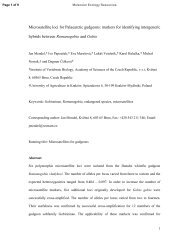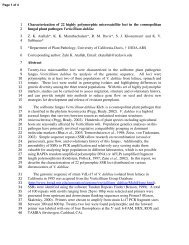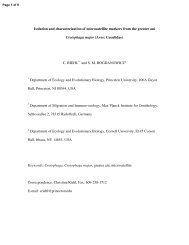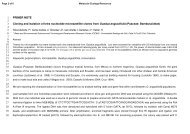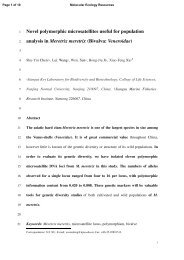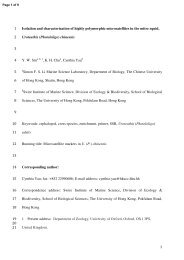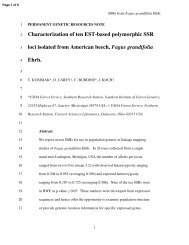Development of eight microsatellite markers in big sagebrush ...
Development of eight microsatellite markers in big sagebrush ...
Development of eight microsatellite markers in big sagebrush ...
You also want an ePaper? Increase the reach of your titles
YUMPU automatically turns print PDFs into web optimized ePapers that Google loves.
Page 1 <strong>of</strong> 8<br />
Molecular Ecology Resources<br />
1<br />
2<br />
<strong>Development</strong> <strong>of</strong> <strong>eight</strong> <strong>microsatellite</strong> <strong>markers</strong> <strong>in</strong> <strong>big</strong> <strong>sagebrush</strong> (Artemisia tridentata<br />
Nutt.)<br />
3<br />
4<br />
S. ISHIZAKI 1 , S. KUBOTA 1 , K. SHIOJIRI 2 , R. KARBAN 3 and M. OHARA 1<br />
5<br />
6<br />
7<br />
8<br />
9<br />
1 Course <strong>in</strong> Ecological Genetics, Graduate School <strong>of</strong> Environmental Science,<br />
Hokkaido University, Sapporo 060-0810, Japan<br />
2 Center <strong>of</strong> Ecological Research, Kyoto University, Otsu 520-2113, Japan<br />
3 Department <strong>of</strong> Entomology, University <strong>of</strong> California, Davis, CA 95616, USA<br />
10<br />
11<br />
12<br />
Key words: <strong>in</strong>duced resistance, volatile communication, herbivory,<br />
dual-suppression-PCR, genetic structure, <strong>microsatellite</strong><br />
13<br />
14<br />
15<br />
16<br />
17<br />
18<br />
Correspondence to: Masashi Ohara, Graduate School <strong>of</strong> Environmental Science,<br />
Hokkaido University, Sapporo 060-0810, Japan<br />
E-mail: ohara@ees.hokudai.ac.jp<br />
FAX/TEL: +81-11-706-4525<br />
Runn<strong>in</strong>g Title: Microsatellite <strong>markers</strong> <strong>of</strong> A. tridentata<br />
1
Molecular Ecology Resources<br />
Page 2 <strong>of</strong> 8<br />
19<br />
20<br />
21<br />
22<br />
23<br />
24<br />
25<br />
26<br />
Abstract<br />
We developed <strong>eight</strong> polymorphic <strong>microsatellite</strong> (SSR) loci from genomic DNA <strong>of</strong> <strong>big</strong><br />
<strong>sagebrush</strong> Artemisia tridentata Nutt. us<strong>in</strong>g a dual suppression-PCR technique and an<br />
improved technique. These <strong>markers</strong> with four to <strong>eight</strong>een alleles per locus successfully<br />
dist<strong>in</strong>guished each <strong>in</strong>dividual collected from a population <strong>in</strong> California, USA. The<br />
observed and expected heterozygosities raged from 0.045 to 0.850 and 0.194 to 0.897,<br />
respectively. These SSR <strong>markers</strong> will be available to identify genets and evaluate<br />
genetic relationship between <strong>in</strong>dividuals <strong>of</strong> A. tridentata.<br />
2
Page 3 <strong>of</strong> 8<br />
Molecular Ecology Resources<br />
27<br />
28<br />
29<br />
30<br />
31<br />
32<br />
33<br />
34<br />
35<br />
36<br />
37<br />
38<br />
39<br />
40<br />
41<br />
42<br />
43<br />
44<br />
45<br />
46<br />
47<br />
48<br />
49<br />
50<br />
Big <strong>sagebrush</strong> (Artemisia tridentata Nutt.) is the dom<strong>in</strong>ant plant <strong>of</strong> the Great Bas<strong>in</strong><br />
region <strong>of</strong> Western North America (McArthur & Sanderson 1999). Artemisia tridentata<br />
has an extensive list <strong>of</strong> herbivores (Wiens et al. 1991) <strong>in</strong>clud<strong>in</strong>g vertebrates and <strong>in</strong>sects<br />
<strong>of</strong> almost every feed<strong>in</strong>g guild. Artemisia tridentata <strong>in</strong>duces its own systemic resistance<br />
via airborne volatiles which are released from damaged leaves (Karban et al. 2006). In<br />
addition, these volatiles also <strong>in</strong>duce systemic resistance <strong>of</strong> <strong>in</strong>tact neighbor<strong>in</strong>g plant<br />
grow<strong>in</strong>g up to 60cm apart from the damaged <strong>in</strong>dividual <strong>in</strong> the field (Karban et al.<br />
2006), which is referred to as volatile communication. The <strong>in</strong>duction <strong>of</strong> resistance <strong>in</strong><br />
neighbor<strong>in</strong>g plant would appear to benefit to the neighbor<strong>in</strong>g plant by reduc<strong>in</strong>g<br />
herbivory, that is, volatile communication may be altruistic. Therefore, to evaluate the<br />
ecological and evolutionary impact <strong>of</strong> volatile communication, it is important to reveal<br />
the genetic relationship between plants that emit the volatiles and plants that receive<br />
those. Thus, we isolated <strong>microsatellite</strong> <strong>markers</strong> from A. tridentata to <strong>in</strong>vestigate the<br />
genetic relationship between <strong>in</strong>dividuals grow<strong>in</strong>g <strong>in</strong> natural population.<br />
Total DNA was extracted from fresh leaves <strong>of</strong> A. tridentata with<br />
cetyltrimethyl ammonium bromide (CTAB) method (Stewart & Via 1993). We isolated<br />
<strong>microsatellite</strong>s us<strong>in</strong>g a dual-suppression-polymerase cha<strong>in</strong> reaction (PCR) method<br />
(Lian & Hogetsu 2002) and an improved technique (Lian et al. 2006). Briefly, <strong>in</strong> order<br />
to construct adaptor ligated DNA libraries, DNA was digested separately us<strong>in</strong>g the<br />
restriction enzymes Afa I, Alu I, EcoR V, Hae III, and Ssp I. The fragments produced<br />
by each restriction enzyme were then ligated to an unequal length adaptor (see, Lian &<br />
Hogetsu 2002), us<strong>in</strong>g a DNA Ligation Kit version 2.1 (Takara). The DNA fragments<br />
with a <strong>microsatellite</strong> at one end were amplified from the Afa I DNA library us<strong>in</strong>g SSR<br />
primer (AC) 6 (AG) 5 , (AG) 6 (AC) 5 , (AC) 6 (TC) 5 or (TC) 6 (AC) 5 and an adaptor primer<br />
3
Molecular Ecology Resources<br />
Page 4 <strong>of</strong> 8<br />
51<br />
52<br />
53<br />
54<br />
55<br />
56<br />
57<br />
58<br />
59<br />
60<br />
61<br />
62<br />
63<br />
64<br />
65<br />
66<br />
67<br />
68<br />
69<br />
70<br />
71<br />
72<br />
73<br />
74<br />
AP2 (5’-CTATAGGGCACGCGTGGT-3’) accord<strong>in</strong>g to Lian et al. (2006). The<br />
fragments amplified by (AC) 6 (TC) 5 and (TC) 6 (AC) 5 were purified by QIAquick PCR<br />
Purification Kit (QIAGEN). The purified fragments were cloned <strong>in</strong>to pDrive Clon<strong>in</strong>g<br />
Vector and the plasmids were transformed <strong>in</strong>to QIAGEN EZ Competent Cells, us<strong>in</strong>g<br />
PCR Clon<strong>in</strong>g plus Kit (QIAGEN). The cloned fragments were amplified us<strong>in</strong>g the M4<br />
forward and M13 reverse primers from the plasmid DNA <strong>of</strong> positive clones. These<br />
products were purified as described above, and then, sequenced directly us<strong>in</strong>g the<br />
BigDye Term<strong>in</strong>ator Cycle Sequenc<strong>in</strong>g Kit (Applied Biosystems) with the ABI PRISM<br />
3100 automated sequencer (Applied Biosystems).<br />
For each fragment amplified by the (AC) 6 (TC) 5 or (TC) 6 (AC) 5 primer, a<br />
locus-specific primer (IP1) was designed from the sequenced region flank<strong>in</strong>g the SSR.<br />
The primer pairs <strong>of</strong> IP1 primer and SSR primer were used as a SSR marker (Lian et al.<br />
2006).<br />
To <strong>in</strong>vestigate <strong>microsatellite</strong> polymorphism, 40 leaves collected from A.<br />
tridentata population at Sagehen Creek, north <strong>of</strong> Truckee, California, USA were used.<br />
PCR amplification was carried out with the GeneAmp PCR system 9700 thermal<br />
cycler (Applied Biosystems) <strong>in</strong> a reaction mixture (10 µL) conta<strong>in</strong><strong>in</strong>g 5 ng <strong>of</strong> template<br />
DNA, 0.2 mM <strong>of</strong> each dNTP (Applied Biosystems), 10 x PCR buffer with 1.5 mM<br />
MgCl 2 (Applied Biosystems), 0.25 U <strong>of</strong> Ampli Taq Gold DNA polymerase (Applied<br />
Biosystems), and two primers: IP1 (0.5 µM) and the SSR primer (fluorescent<br />
dye-labeled, 0.5 µM). The PCR condition was 9 m<strong>in</strong> at 94 °C, 35 cycles <strong>of</strong> 30 sec at<br />
94 °C, 30 sec at the anneal<strong>in</strong>g temperature and 1 m<strong>in</strong> at 72 °C, followed by 72 °C for 7<br />
m<strong>in</strong>. The PCR products were detected with an ABI PRISM 3100 automated sequencer<br />
(Applied Biosystems).<br />
4
Page 5 <strong>of</strong> 8<br />
Molecular Ecology Resources<br />
75<br />
76<br />
77<br />
78<br />
79<br />
80<br />
81<br />
82<br />
83<br />
84<br />
85<br />
86<br />
87<br />
88<br />
89<br />
90<br />
91<br />
92<br />
93<br />
We successfully identified <strong>eight</strong> SSR loci with polymorphism and<br />
codom<strong>in</strong>ance from A. tridentata (Table 1). Forty genotypes were detected <strong>in</strong> 40<br />
samples analyzed by these <strong>markers</strong>. The number <strong>of</strong> alleles per locus ranged from four<br />
to 18 per locus, with an average <strong>of</strong> 7.63 (Table 1). The observed and expected<br />
heterozygosities calculated us<strong>in</strong>g CERVUS version 3.0.3 (Kal<strong>in</strong>owski et al. 2007)<br />
ranged from 0.045 to 0.850 and 0.194 to 0.897, respectively. Statistical tests for<br />
Hardy-We<strong>in</strong>berg equilibrium and l<strong>in</strong>kage disequilibrium were conducted with<br />
GENEPOP version 3.4 (Raymond & Rousset 1995) us<strong>in</strong>g default values for Markov<br />
cha<strong>in</strong> parameters. We also estimated the frequency <strong>of</strong> null alleles us<strong>in</strong>g Brookfield I<br />
method (2000 permutation) implemented <strong>in</strong> the program MICRO-CHECKER version<br />
2.2.3 (Van Oosterhout et al. 2004). Three <strong>of</strong> <strong>eight</strong> loci showed significant deviation<br />
from Hardy-We<strong>in</strong>berg equilibrium (HWE) after Bonferroni correction (overall α =<br />
0.01) due to heterozygote deficiency (Table 1). Because the three loci exhibited high<br />
levels <strong>of</strong> null allele frequencies (0.197, 0.278 and 0.377 for AT4, AT13 and AT25,<br />
respectively; α = 0.05), we assume that presence <strong>of</strong> null alleles are responsible for the<br />
deviation from HWE. There were no significant l<strong>in</strong>kage disequilibriums between the<br />
<strong>eight</strong> loci (α = 0.05). These <strong>markers</strong> are currently be<strong>in</strong>g used to analyze the genetic<br />
relationship between A. tridentata <strong>in</strong>dividuals grow<strong>in</strong>g <strong>in</strong> natural population <strong>in</strong><br />
California, USA.<br />
94<br />
95<br />
96<br />
97<br />
98<br />
Acknowledgement<br />
This study was supported by the JSPS for Scientific Research (21657006), research<br />
fellowships <strong>of</strong> the JSPS for Young Scientists to S. Kubota and K. Shiojiri, the Clark<br />
Memorial Foundation to S. Ishizaki and the M<strong>in</strong>istry <strong>of</strong> Education, Culture, Sports,<br />
5
Molecular Ecology Resources<br />
Page 6 <strong>of</strong> 8<br />
99<br />
Science and Technology <strong>of</strong> Japan for Global Centers <strong>of</strong> Excellence Program (J01).<br />
100<br />
101<br />
102<br />
103<br />
104<br />
105<br />
106<br />
107<br />
108<br />
109<br />
110<br />
111<br />
112<br />
113<br />
114<br />
115<br />
116<br />
117<br />
118<br />
119<br />
120<br />
121<br />
122<br />
References<br />
Kal<strong>in</strong>owski ST, Taper ML, Marshall TC (2007) Revis<strong>in</strong>g how the computer program<br />
Cervus accommodates genotyp<strong>in</strong>g error <strong>in</strong>creases success <strong>in</strong> paternity assignment.<br />
Molecular Ecology, 16, 1099-1106.<br />
Karban R, Shiojiri K, Huntz<strong>in</strong>ger M, McCall AC (2006) Damage-<strong>in</strong>duced resistance <strong>in</strong><br />
<strong>sagebrush</strong>: volatiles are key to <strong>in</strong>tra- and <strong>in</strong>terplant communication. Ecology, 87,<br />
922-930.<br />
Lian C, Hogetsu T (2002) <strong>Development</strong> <strong>of</strong> <strong>microsatellite</strong> <strong>markers</strong> <strong>in</strong> black locust<br />
(Rob<strong>in</strong>ia pseudoacacia) us<strong>in</strong>g a dual-supression-PCR technique. Molecular<br />
Ecology Notes, 2, 211-213.<br />
Lian C, Wadud MA, Geng Q, Shimatani K, Hogetsu T (2006) An improved technique<br />
for isolat<strong>in</strong>g codom<strong>in</strong>ant compound <strong>microsatellite</strong> <strong>markers</strong>. Journal <strong>of</strong> Plant<br />
Research, 119, 415-417.<br />
McArthur ED, Sanderson SC (1999) Cytogeography and chromosome evolution <strong>of</strong><br />
subgenus Tridentatae <strong>of</strong> Artemisia (Asteraceae). American Journal <strong>of</strong> Botany, 86,<br />
1754-1775.<br />
Stewart CN Jr., Via LE (1993) A rapid CTAB DNA isolation technique useful for<br />
RAPD f<strong>in</strong>gerpr<strong>in</strong>t<strong>in</strong>g and other PCR applications. BioTechniques 14,748-750<br />
Raymond M, Rousset F (1995) GENEPOP (version 1.2): population genetics s<strong>of</strong>tware<br />
for exact tests and ecumenicism. Journal <strong>of</strong> Heredity, 86, 248-249. Available at<br />
http://genepop.curt<strong>in</strong>.edu.au/<br />
Van Oosterhout C, Hutch<strong>in</strong>son WF, Wills DPM, Shipley P (2004) MICRO-CHECKER:<br />
6
Page 7 <strong>of</strong> 8<br />
Molecular Ecology Resources<br />
123<br />
124<br />
125<br />
126<br />
127<br />
s<strong>of</strong>tware for identify<strong>in</strong>g and correct<strong>in</strong>g genotyp<strong>in</strong>g errors <strong>in</strong> <strong>microsatellite</strong> data.<br />
Molecular Ecology Notes, 4, 535-538.<br />
Wiens JA, Cates RG, Rotenberry JT, Cobb N, Van Horne B, Redak RA (1991)<br />
Arthropod dynamics on <strong>sagebrush</strong> (Artemisia tridentata): effects <strong>of</strong> plant chemistry<br />
and avian predation. Ecological Monographs, 61, 299-321.<br />
7
Molecular Ecology Resources<br />
Page 8 <strong>of</strong> 8<br />
Table 1 Characteristics <strong>of</strong> <strong>eight</strong> <strong>microsatellite</strong> loci from A. tridentata.<br />
Primer sequence (5' ~ 3') T a Size range No. <strong>of</strong> GeneBank<br />
Locus Repeat and fluorescent label ( o C) (bp) alleles H O H E Accession no.<br />
AT2 (TC) 6 (AC) 7 TCTCTCTCTCTCACACACACAC 57 100-105 4 0.513 0.611 AB488553<br />
(NED)CTTGCCCATTGTGATTATTTTGAC<br />
AT4 (TC) 6 (AC) 5 TCTCTCTCTCTCACACACACAC 60 104-116 10 0.432 0.794 * AB488554<br />
...(AC) 4 (VIC)AAGCATTGGCAAAACGTGAGATTA<br />
AT13 (AC) 6 (TC) 9 ACACACACACACTCTCTCTCTC 57 293-356 18 0.361 0.897 * AB488555<br />
(NED)TTCAACGAGTTTCACTCCAGTTTA<br />
AT15 (AC) 6 (TC) 5 ACACACACACACTCTCTCTCTC 60 102-121 8 0.769 0.790 AB488556<br />
...(AC) 13 ...(TC) 3 (PET)GGTACTACTAGCTAACAGTTGAAT<br />
AT16 (AC) 6 (TC) 9 ACACACACACACTCTCTCTCTC 58 138-158 12 0.850 0.846 AB488557<br />
(VIC)TAAGAAGCTCTTGCTTTGAAGCTC<br />
AT22 (TC) 6 (AC) 5 T- TCTCTCTCTCTCACACACACAC 58 138-153 9 0.525 0.641 AB488558<br />
(AC) 2 T(AC) 3 (FAM)ACATAAGGGCCACAAAACAAAGTC<br />
AT25 (AC) 6 (TC) 6 ACACACACACACTCTCTCTCTC 60 160-168 5 0.045 0.692 * AB488559<br />
...(AC) 4 (FAM)TAGTGGAGCGTTTCTTGAACTCTG<br />
AT28 (AC) 6 (TC) 6 ACACACACACACTCTCTCTCTC 58 244-255 5 0.103 0.194 AB488560<br />
...(CA) 4 ...(AC) 3 (VIC)GATAACGATTCAACTCGGTCAACA<br />
T a , anneal<strong>in</strong>g temperature <strong>of</strong> the primer pair; H O , observed heterozygosity; H E , expected heterozygosity.<br />
* <strong>in</strong>dicates significant deviation from Hardy-We<strong>in</strong>berg equilibrium after Bonferroni correction (adjusted P < 0.0013)




